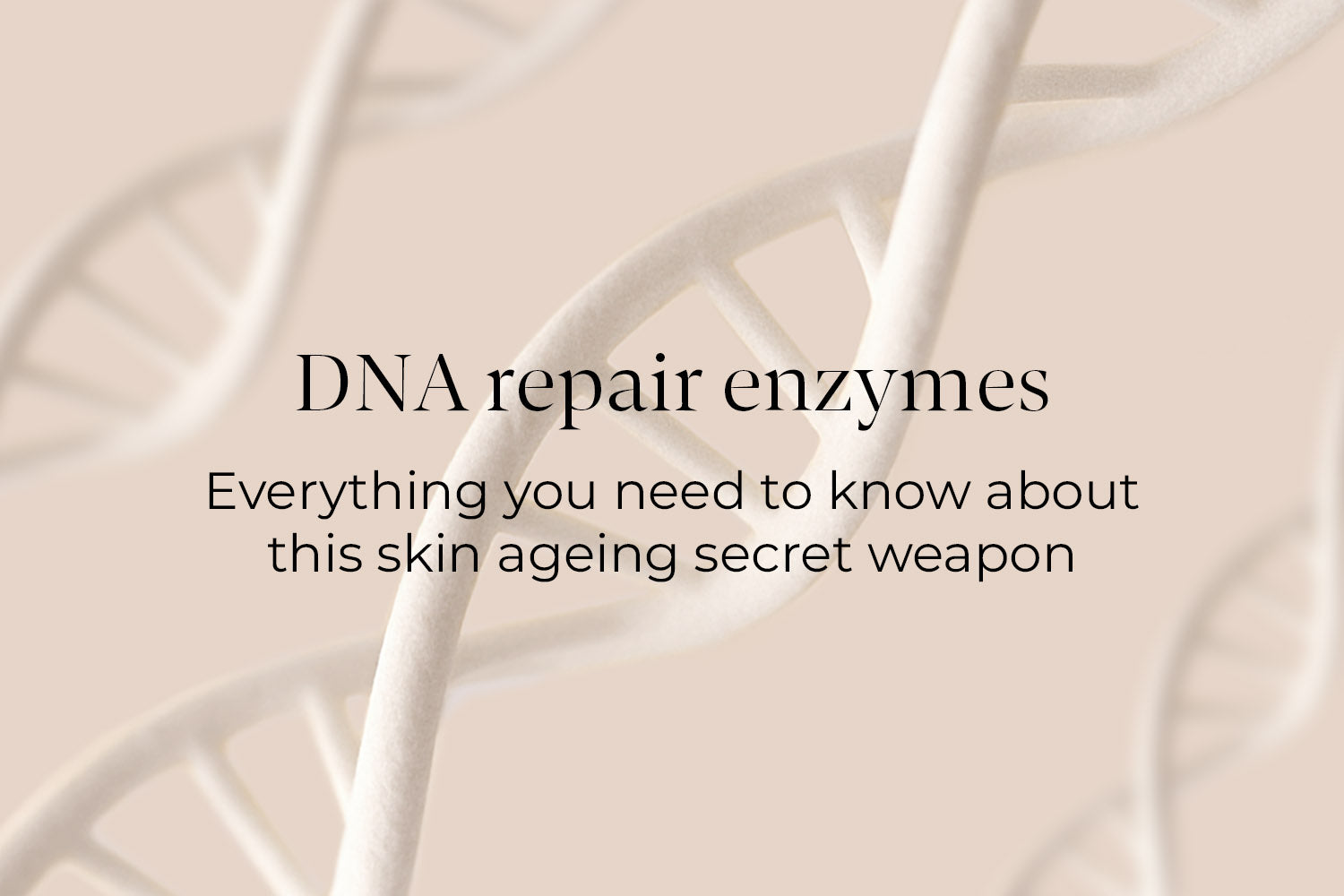You’re going to hear The Skin Diary team talking a lot about DNA Repair Enzymes. That’s because our latest launch — Age Defence Moisturising Day Cream — contains the hero ingredient of DNA Repair Enzymes and it’s a formula we’re incredibly proud of.
We’re going to look into exactly what these are, how they can help in your skincare routine and how we’ve used them in our formula to give you maximum protection from UV damage.
What are DNA repair enzymes and why are they important?
DNA repair enzymes are proteins that are responsible for keeping our DNA integrity in check. Our body is pretty good at repairing DNA damage caused by UV exposure, but it doesn’t always catch and repair everything. As we age, this ability declines so we need a little more help. The good news is, that’s where DNA repair enzymes come in. DNA repair enzymes are clever little repairing agents that look for DNA damage caused by UV damage in order to fix them.
We use two repair enzymes in Age Defence Moisturising Day Cream:
1. Photolyase
Photolyase is an enzyme we need to help repair our enzyme but we lost our ability to produce it through evolution so this means we need to replace this for optimal DNA repair.
It works to repair the small chinks in our DNA helix, which are called cyclobutane pyrimidine dimers (CPDs). Photolyase searches for these chinks and waits for a photon of light to give it energy to go in and repair this CPD damage instantly — a process called photoreactivation.
2. UV Endonuclease
The second type of DNA repair enzyme is something called UV endonuclease, working to simulate our natural DNA repair. Our body repairs DNA through nucleotide excision repair (NER), however, as we age, this repair slows. UV Endonuclease works to enhance our natural NER and doesn’t require a photon of light to work (as photolyase does).
Do DNA repair enzymes work?
The short answer is: Yes! The science proves that they work and it’s incredibly exciting. DNA repair enzymes are designed to fix UV-induced damage at a cellular level, helping your skin recover from UV damage before it leads to premature ageing or even skin cancer. Studies show that incorporating DNA repair enzymes into skincare can help reduce UV-related cellular damage and improve overall skin health.
Think of them as a second line of defence after sunscreen; helping your skin repair itself and prevent future harm. Together, sunscreen and DNA repair enzymes are a skin protecting power duo.
What damage can DNA repair enzymes repair?
DNA repair enzymes target specific types of UV-induced DNA damage, particularly cyclobutane pyrimidine dimers (CPDs) and 6-4 photoproducts. Speeding up the body’s repair process, these enzymes help fix DNA errors before long-term damage is caused. They won’t reverse the skin’s deep structural changes, however, they can significantly reduce these mutations at a cellular level and work to support overall skin health. It’s important to note that DNA repair enzymes cannot restore lost collagen or elastin, so while they help prevent future damage, they can’t completely undo visible signs of ageing.
Think of them as a high-tech repair team, working at the cellular level to keep your skin functioning at its best.
Can DNA repair enzymes help with photoageing?
DNA repair enzymes sure can help with photoageing. Concerns like wrinkles, loss of skin elasticity and hyperpigmentation are largely a result of UV-induced DNA damage, which leads to the breakdown of the skin’s structure, increased inflammation and a slower cell turnover. Studies have shown that DNA repair enzymes work to reduce this damage, which over time, slows premature and visible signs of ageing. This makes them a powerful addition to a well-ageing skincare routine.
Can DNA repair enzymes help reduce pre-cancerous skin changes?
DNA repair enzymes can help reduce the risk of precancerous skin changes. Since DNA repair enzymes repair this DNA damage caused by sun exposure, they reduce the likelihood of mutations that can lead to skin cancer.
Research showed that regular use of DNA repair enzymes in skincare can reduce actinic keratoses, rough, scaly patches caused by long-term sun exposure, which can sometimes develop into skin cancer.
A study found that applying a lotion containing these enzymes significantly lowered the number of new actinic keratoses, and even helped some existing ones regress. That’s why dermatologists recommend them as part of a well-ageing and sun protection routine alongside broad-spectrum sunscreen, particularly if you have a history of sun damage.
Do DNA repair enzymes replace sunscreen?
DNA repair enzymes should never replace sunscreen but rather complement it (and other sun protection methods) in your routine.
Sunscreen blocks new UV damage, while DNA repair enzymes work behind the scenes to fix existing cellular damage.
Sunscreen = seatbelt (prevents harm)
DNA repair enzymes = airbag (minimises damage if something gets through)
Even with diligent SPF use, some UV rays still penetrate the skin and cause damage at the DNA level. DNA repair enzymes help correct errors, reducing the risk of long-term sun damage, wrinkles, and even pre-cancers.
Using both in tandem offers a comprehensive approach: sunscreen minimises new damage, while DNA repair enzymes mitigate the effects of any damage that does occur.

References:
Garcia-Mouronte, E.; Pérez-González, L.A.; Naharro-Rodriguez, J.; Fernández Guarino, M. Understanding Active Photoprotection: DNA-Repair Enzymes and Antioxidants. Life 2024, 14, 822. https://doi.org/10.3390/life14070822
DeBoyes T, Kouba D, Ozog D, Fincher E, Moy L, Iwata K, Moy R. Reduced number of actinic keratoses with topical application of DNA repair enzyme creams. J Drugs Dermatol. 2010 Dec;9(12):1519-21. PMID: 21120260.
Yarosh DB, Rosenthal A, Moy R. Six critical questions for DNA repair enzymes in skincare products: a review in dialog. Clin Cosmet Investig Dermatol. 2019 Aug 29;12:617-624. doi: 10.2147/CCID.S220741. PMID: 31695467; PMCID: PMC6718248





